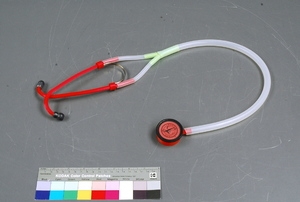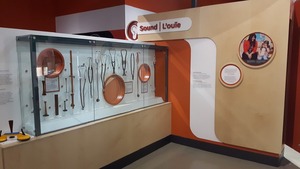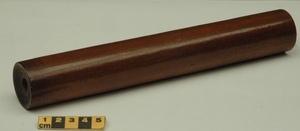Explore the 3D-printed Stethoscope:
3D Printing and Medicine in Developing Countries. My Stethoscope Project
Introduction: Revolutionary Medical Technology
Made by Glia Project project for Open Medical Devices
Date: 2015
Place: Gaza, Palestinian Authority
Art. no. 2017.0002 Ingenium: Canada's Museums of Science and Innovation.
As part of the Glia project for Open Medical Devices, Canadian Physician Tarek Loubani and his colleagues developed this 3D printed stethoscope that was cheap and easy to produce, while having exceptional sound quality. They first made and used this stethoscope in Gaza, Palestinian Authority due to shortages of medical instruments.
This original, complete version was printed in Gaza in August 2015. This model is "red" (green Y-piece because the original broke quickly). This is the first complete stethoscope used in practice. It is seen in this CBC article from that time about Dr. Loubani.
Physical Description
The 3D printed stethoscope is made of 3D printer red and green filament (known as PLA), silicone clear tubing, a diaphragm from a Littmann model stethoscope, a metal spring and black earbuds. There are four 3D printed pieces that make up the stethoscope; the head is bright red shaped like a lolipop; the "Y" piece is neon green; and two ear pieces that are bright red shaped like a cane. The diaphragm comes from a Littmann model stethoscope, which is attached to the head of the stethoscope. The diaphram is a clear circle branded as “Littmann Quality” with a black rim. The head is attached to silicone clear tubbing, which then connects to the Y-piece. The Y-piece attaches on both sides to silicone clear tubbing, which is attached to the ear tubes. These ear tubes attach together with the use of a metal sling that is shaped in a "u" form. The final piece are the earplugs that allow for the sound to travel through from the diaphragm. The stethoscope looks like the letter “Y” when it is worn. It is approximately the length of an arm and is rather light due to the material used. The heaviest part of the stethoscope would be the head, as it uses the most amount of filament that weighs approximately 100 grams.
Reinventing the Stethoscope:
The 3D stethoscope is featured in this historic wall of stethoscopes in the "Sound" Section of the Medical Sensations Exhibit, Canada Science and Technology Museum.
The Glia Project for Open Medical Devices, which is headed by Dr. Tarek Loubani, have created a 3D printed stethoscope that significantly lowers the cost of a commerially sold one. The project came from Dr. Loubani, a Palestinian- Canadian doctor, for the purpose of using in the Gaza strip because of the medical supply shortage that left Gaza City’s main hospital Al-Shifa Hospital with only one stethoscopes (Western University, 2018).This is a cutting-edge project that will change the way medical tools are produced in developing countries. Dr. Loubani conceptualized it by being inspired by his nephew’s toy stethoscope, which would change the way doctors in developing countries worked (Porup, 2015). The 3D printed stethoscope was made in Gaza in 2012 during an eight-day Israeli/Palestinian war. Dr. Loubani’s understands as doctor who has worked in Gaza the necessity for a stethoscope in order to “normalize” it has part of the practice in hospitals. In order to do this, he has recognized the need for a low costing, high quality stethoscope that will help doctors in areas that need them.
Dr. Loubani's 3D stethoscope is currently on display at Canada's Science and Technology Museum in Ottawa, ON.
Breaking the Sound Barrier
This replica of the original monaural stethoscope is featured in this historic wall of stethoscopes in the "Sound" Section of the Medical Sensations Exhibit, Canada Science and Technology Museum.
This replica of the earliest wooden model was made in 1929, commissioned by Montreal cardiologist Dr. Harold Segall. He based this model on one owned by Dr. William Osler that traced back to René Laennec in 1825.
Art. no. 2002.0473, Maker: Unknown, Date: 1929, Ingenium: Canada's Museums of Science and Innovation
René Laennec, a French physician, created the first stethoscope. A simple wooden tube with an opening down the center made in 1816 revolutionized diagnosis (Reiser, 2014). He began by using a technique by Hippocrates, which involved placing your ear to the patient’s chest to hear for noises, referred to as auscultation. He was limited through this method because it was unorthodox then and unpleasant, especially to women who male physicians typically refrained from doing (Reiser, 2014, p.5). In order to understand what was wrong with his female patient he had to think outside the box. He remembered a general rule of sound growing louder when passing through solid bodies. This broke down the social and physical barriers of Hippocrates method of auscultation. Laennec used tightly rolled paper into a cylinder and found a clearer sound then auscultation method. He proceeded to produce a straight wooden tube about a foot long and an inch and a half diameter. It resembled a trumpet, as it neared the patient end it gradually flared out. Laennec called it the cylinder, but slowly changed to the stethoscope, which meant in Greek “chest” and “I view” (Reiser, 2014, p.6). Mediate auscultation was the practice of listening via an instrument (Duffin, 1998).
Bibliography
Duffin, J. (1998).To see with a better eye: a life of R.T.H. Laennec. Princeton, NJ: Princeton University Press.
Goehrke, S. A. (2015). Made in Gaza: Glia Project Offers Open Source, Low-Cost, Locally 3D Printed Medical Supplies. Retrieved from https://3dprint.com/95097/project-glia-gaza-strip/Reiser, S. J. (2014). Technological medicine: the changing world of doctors and patients(1. paperback ed). New York, NY: Cambridge Univ. Press.
Porup, J. M. (2015, August 21). This 3D-Printed Stethoscope Costs $5, Outperforms $200 Competitors. Retrieved April 13, 2018, from https://motherboard.vice.com/en_us/article/539xkn/this-3d-printed-stethoscope-head-costs-5-outperforms-200-competitors
Reiser, S. J. (2014). Technological medicine: the changing world of doctors and patients(1. paperback ed). New York, NY: Cambridge Univ. Press.
Staff, S. (n.d.). Video: A 3D printed stethoscope for doctors with few resources [Text]. Retrieved April 11, 2018, from https://scroll.in/pulse/872180/video-a-3d-printed-stethoscope-for-doctors-with-few-resources
The Associated Press · Posted: Sep. (2015, September 10). Canadian doctor makes stethoscope with 3D printer to deal with Gaza shortage | CBC News. Retrieved April 11, 2018, from https://www.cbc.ca/news/health/dr-tarek-loubani-uses-3d-printer-to-overcome-gaza-stethoscope-shortage-1.3222052
Western University. (n.d.). Research team develops clinically-validated 3D printed stethoscope. Retrieved from https://www.youtube.com/watch?time_continue=156&v=2-iTAfkINiU


